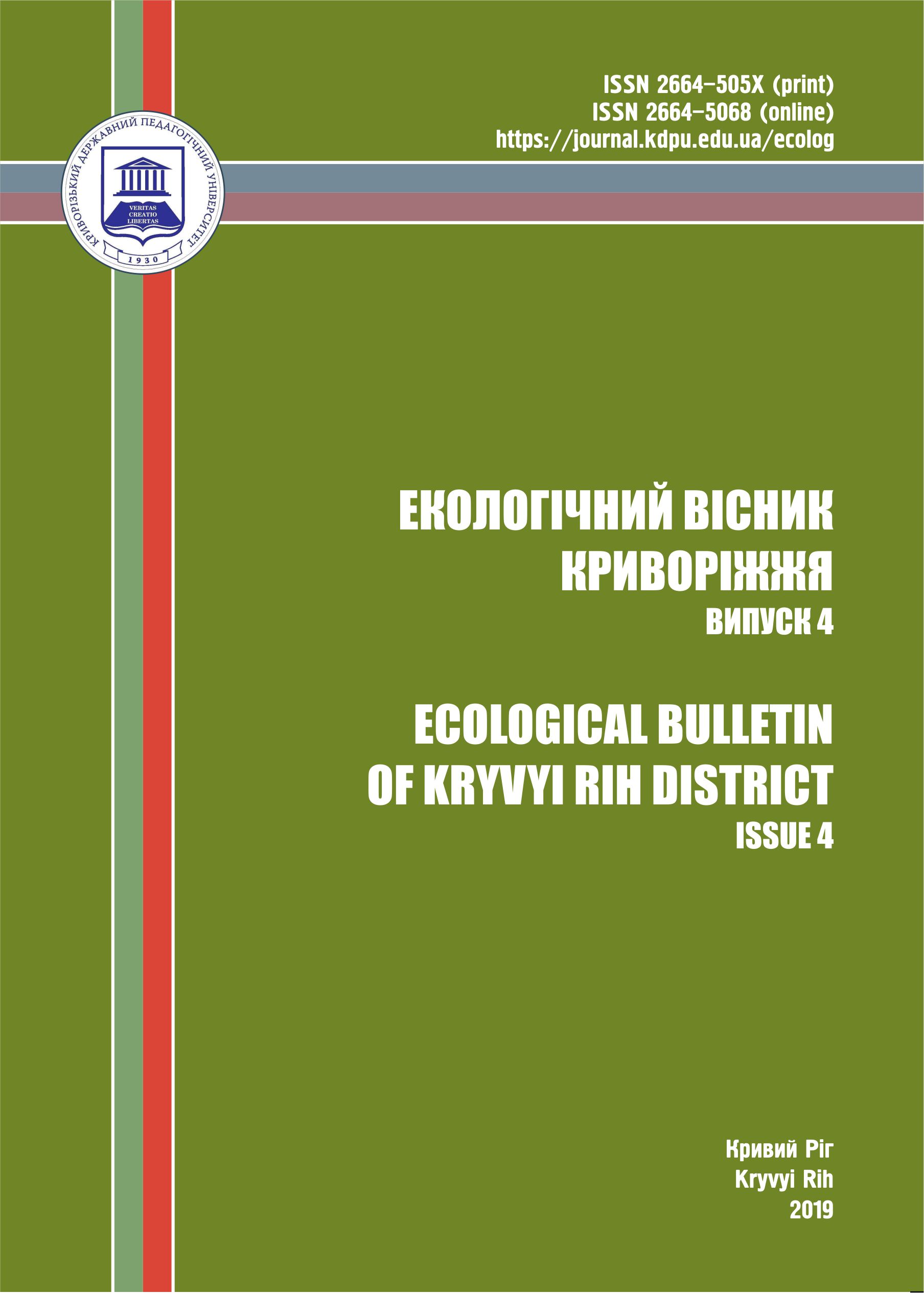Perspectives of use of representatives of the genus complex Hemerocallis L. in antropogenic landscapes at Kryvorizhzhia
DOI:
https://doi.org/10.31812/eco-bulletin-krd.v4i0.2562Keywords:
Hemerocallis L. cv., the features of flowerin, decorative characteristics, KryvorizhzhyaAbstract
The definition of features of flowering and variability of decorative characteristics of varieties of daylilies in the conditions of Kryvorizhzhya was carried out. The group of varieties, thatwas being grown in Kryvyi Rih botanical garden of NAS of Ukraine during 1999–2017, was investigated. The varieties were differed on decorative signs and terms of flowering. It was found that the early-middle varieties began to bloom in terms, which are characteristic for them, while the varieties of medium and mediumlate groups bloomed 12–15 days earlier. They recreated the development of the early-middle group. Flowering of varietal daylilies in our climatic conditions continues for 25–40 days. A significant decrease in the diameter of the flower, relatively to varietal characteristics at 5–41%, was recorded because of hot and dry conditions’ influence. While the height of a stem decreased to only 28%. The varieties are attributed to the groups with the highest and middle level ofadaptation, that allows to use in anthropogenic landscapes with different level of the technogenic loading.
Downloads
Metrics
References
[2] Bаzilеvskаia, N.А., & Маurin, А.М. (1984). Introduktsiya rasteniy. Teorii i prakticheskiye priyemy: Uchebnoye posobiye [Plant introduction. Theories and practical techniques: Tutorial]. P. Stuchki Latvian State University, Riga (in Russian).
[3] Bylоv, V.N. (1971). Osnovy sortoizucheniya i sortootsenki dekorativnykh rasteniy pri introduktsii [Basics of variety studies and variety estimates of ornamental plants during the introduction]. Byulleten Glavnogo botanicheskogo sada [Bulletin of the Main Botanical Garden], 81, 69–75 (in Russian).
[4] Bzhytskikh, N.V. (2009). Sravnitel’naya otsenka sortov i gibridov lileynika i effektivnye sposoby ikh razmnozheniya v usloviyakh umerenno-zasushlivoy i kolochnoy stepi Altayskogo kraya. [Comparative evaluation of varieties and hybrids of the daylily and effective methods of their reproduction in ponditions of moderately arid and hilly steppe of the Altai Territory]. (Doctor of Philosophy’s thesis, Agriculture). Altai State University, Barnaul (in Russian).
[5] Catalog Bells, (2002). Bill s Joyce, Reinke.
[6] Chypylyak, T. F. (2013). Heohrafichne poshyrennia i umovy zrostannia vydiv rodu Hemerocallis L. ta perspektyvnist yikh introduktsiyi na Ukrayini [Geographical distribution and conditions of growth of species of the genus Hemerocallis L. and prospects of their introduction
in Ukraine]. Introduktsiia roslyn [Plant introduction], 1, 46–54 (in Ukrainian).
[7] Chypylyak, T. F. (2014). Ekoloho-biolohichni osoblyvosti predstavnykiv rodu Hemerocallis L. pry introduktsiyi v Kryvorizkyy botanichnyy sad NAN Ukrayiny [Ecological and biological features of the genus Hemerocallis L. at the introduction into the Kryvyi Rih Botanic Garden NAS of Ukraine]. Naukovyy visnyk Chernivetskoho universytetu. Biolohichni systemy [Scientific Herald of Chernivtsy University.
Biological Systems], 6(2), 205–210 (in Ukrainian).
[8] Chypylyak, T. F., & Gryshkо, V.M. (2014). Osoblyvosti fiziolohichnoyi adaptatsiyi Hemerocallis lilioasphodelus L. i Hemerocallis middendorffii Trautv. et Meyer (Hemerocallidaceae) do tekhnohennoho zabrudnennia [Features physiological adaptation of Hemerocallis lilioasphodelus L., H. middendorffii Trautv. et Meyer (Hemerocallidaceae) to the conditions of technogenic pollution]. Ukrayinskyy Botanichnyy zhurnal [Ukrainian Botanical Journal], 71(5), 614–619 (in Ukrainian).
[9] Chypylyak, T. F., Mazura, M.Yu., Bereslavska, O.O., & Leshchenyuk, O.M. (2014). Kvitnykovo-dekoratyvne oformlennia parkiv ta skveriv mista Kryvyi Rih. Stan, problemy, rekomendatsii shchodo yohopolipshennia [Flower-decorative design of parks and squares at Kryvyi Rih City. Recommendations for improving it]. Naukovyi visnyk NLTU Ukrainy [Scientific Bulletin of NLTU of Ukraine], 24.4, 164–169 (in Ukrainian).
[10] Greuter, W. (2000). International Code of Botanical Nomenclature (Saint Louis Code). Adopted by 16th International Botanical Congress St. Louis, Missouri.
[11] Grodzinskiy, D.M. (2013). Adaptivnaya strategiya fiziologicheskikh protsessov rasteniy [The adaptive strategy physiological processes of plant]. Naukova dumka, Kyiv (in Russian).
[12] Hlukhоv, О. Z., Sаzоnоv, А. I., & Khyzhniak, N.А. (2006). Fitoindykatsiya metalopresynhu v antropohenno transformovanomu seredovyshchi [Phytoindication metalopersynhu in anthropogenically transformed environment]. Nord-Pres, Donetsk (in Russian).
[13] Gryshkо, V.M., & Chypylyak, T. F. (2011). Autekolohiia vydiv i sortiv Nemerocallis L. (rozvytok heneratyvnoyi sfery) v umovakh tekhnohennoho zabrudnennia [Autocology of species and varieties of Nemerocallis L. (development of generative sphere) in the conditions of technogenic pollution]. Dopovidi Natsionalnoyi akademiyi nauk Ukrayiny [Reports of the National Academy of Sciences of Ukraine], 12, 138–147 (in Ukrainian).
[14] Коrdium, Е. L., Sytniк, К.M., Bаrаnеnkо, V.V., Bеliavskаia, N.А., & Кlimchuk, D.А. (2003). Kletochnyye mekhanizmy adaptatsii rasteniy k neblagopriyatnym vozdeystviyam ekologicheskikh faktorov v estestvennykh usloviyakh [Cellular mechanisms of plant adaptation to the adverse effects of environmental factors in natural conditions]. Naukova dumka, Kyiv (in Russian).
[15] Коshkin, Е. I. (2010). Fiziologiya ustoychivosti sel’skokhozyaystvennykh kul’tur [Physiology of crop sustainability]. Drof, Moscow (in Russian).
[16] Кrеstоvа, I.N. (2010). Rod Hemerocallis L. (semeystvo Hemerocallidaceae) v usloviyakh kul’tury v Primorskom kraye. [Hemerocallis L. (Hemerocallidaceae family) in culture in Primorsky District]. (Doctor of Philosophy’s thesis, Biology). Vladivostok State University, Vladivostok (in Russian).
[17] Lin, Y. L., Lu, C.K., Huang, Y. J., & Chen, H. J. (2011). Antioxidative caffeoylquinic acids and flavonoids from Hemerocallis fulva flowers. Journal of Agricultural and Food Chemistry, 59, 8789–8795.
[18] Metodika fenologicheskikh nablyudeniy v botanicheskikh sadakh SSSR, (1975). [The methodology of phenological observations in the botanical gardens of the USSR]. Main Botanical Garden of the USSR Academy of Sciences, Moscow (in Russian).
[19] Smоlinskаia, М.А. (2002). Otsenka uspeshnosti introduktsii travyanistykh rasteniy [Evaluation of the success of the introduction of herbaceous plants]. Naukovyy visnyk Chernivetskoho universytetu. Biolohichni systemy [Scientific Herald of Chernivtsy University. Biological Systems], 145, 164–168 (in Russian).






